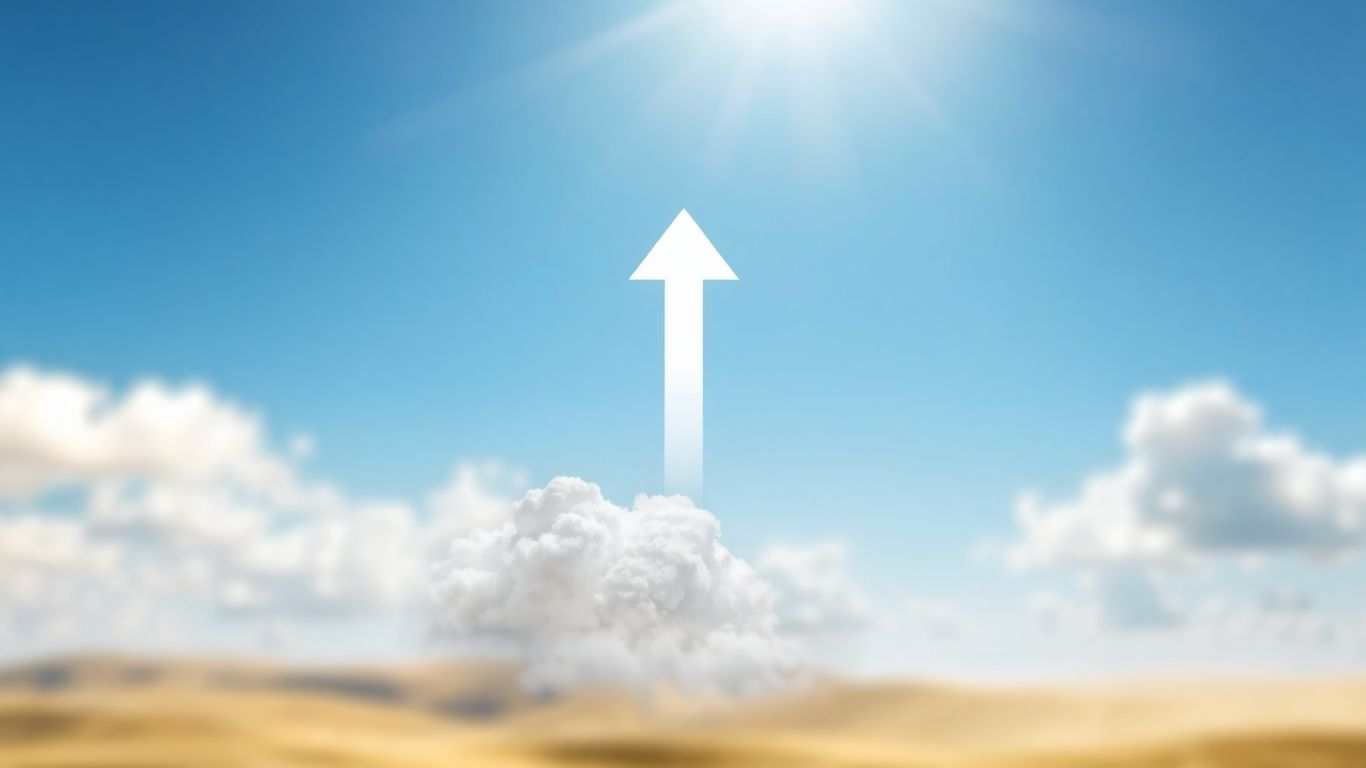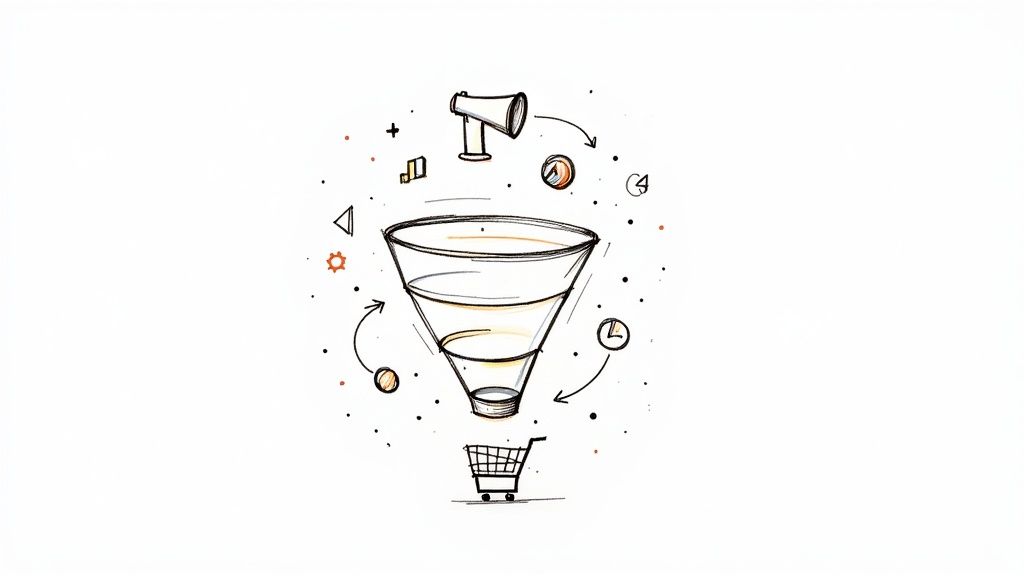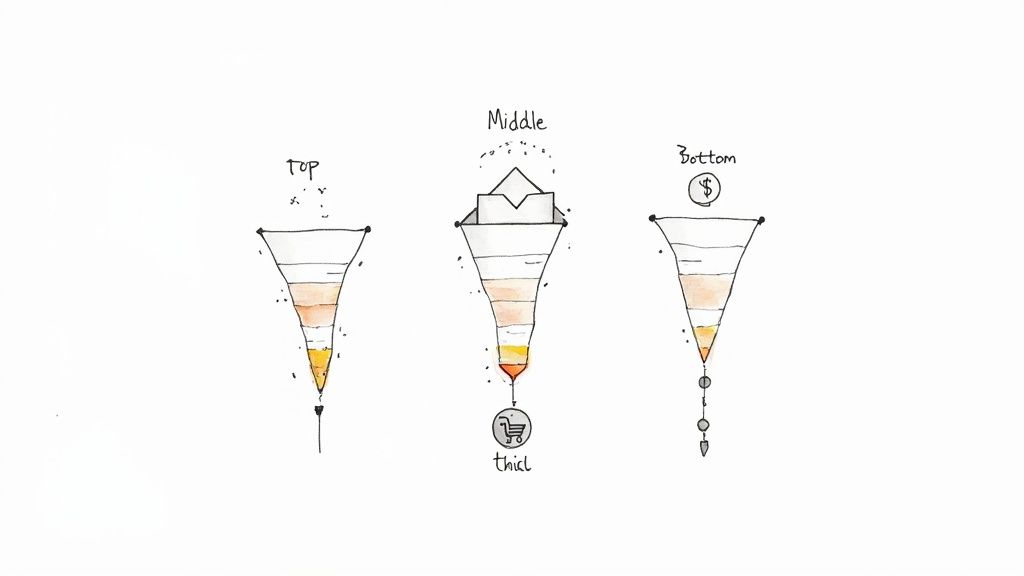
Mastering Demand Generation: Proven Strategies for Business Growth
Master demand generation with proven strategies for business growth. Learn to build awareness, attract prospects, and drive revenue.

A conversion funnel is a roadmap, tracing each step from when someone first notices your brand to the moment they make a purchase. It shines a light on where prospects stall and where they glide through. With this visual guide, you can tighten up your marketing and plug any leaks.
Think of a kitchen funnel you use to pour liquids. The wide top catches a lot, and only a little flows through the narrow end. A conversion funnel works the same way for your audience: it captures wide interest and narrows down to the people who complete a conversion.
This idea emerged in the early 2000s as e-commerce boomed and brands needed a way to mirror real-world sales steps online. Today, it’s essential for spotting drop-off points and refining every stage of your customer journey.
Not every visitor is ready to buy right away. Breaking the journey into stages lets you meet people where they are. By crafting the right message at each step, you guide prospects forward without overwhelming them.
A conversion funnel creates a clear roadmap from first contact to purchase. It turns scattered tactics into a unified strategy that moves the needle.
Here’s what focusing on your funnel can do:
Below is a quick overview of the AIDA funnel, showing how customer mindsets shift and business goals align.
The Four Core Stages of a Conversion Funnel
Use this table as a starting point to map your own funnel. On average, sales funnels convert around 2.35% of visitors. Top-performing companies often climb above 5.31% by fine-tuning every step. Zeroing in on weak spots is what turns casual browsers into loyal customers.
Think of a conversion funnel less as a single, straight road and more like a journey with a few key stops. To understand customer needs, marketers usually break this journey into three core stages: the Top of the Funnel (TOFU), the Middle of the Funnel (MOFU), and the Bottom of the Funnel (BOFU).
Each stage reflects the customer's mindset—from realizing they have a problem, to actively looking for solutions, and finally, deciding on the best one. If you can match your marketing to their mindset at each point, you'll have an easier time guiding them forward.
At the Top of the Funnel (TOFU), your main job is to attract as many relevant people as possible. These folks are just starting to identify their problem or need and are looking for answers. This is not the time for a hard sell; it’s all about educating and informing.
Some great content for this stage includes:
The classic AIDA model (Awareness, Interest, Desire, Action) aligns perfectly with the funnel concept, starting here at the top with Awareness.

As you can see, the funnel starts wide and gets narrower as people move through, their interest becoming more specific until they’re ready to act.
Once you’ve grabbed someone’s attention, they slide into the Middle of the Funnel (MOFU). They're no longer just browsing—they're actively comparing options. Your goal here is to build trust and show them why you're the best solution. This is where you nurture a what is a marketing qualified lead.
Finally, at the Bottom of the Funnel (BOFU), prospects are on the verge of making a decision. All they need is that final nudge.
BOFU content is all about closing the deal. Think demos, free trials, and customer success stories—anything that provides clear proof and takes the risk out of saying "yes."

Understanding your conversion funnel is one thing, but measuring its performance is another. To know if your strategy is paying off, you have to look past vanity metrics and focus on the numbers that show how people behave at each step.
At the top of your funnel (TOFU), it’s all about attraction. You're casting a wide net, so track metrics like website traffic, new visitors, and impressions. These numbers tell you how many people you’re pulling in.
Once people drift into the middle of the funnel (MOFU), the game changes to engagement. Key metrics are lead magnet downloads, email open rates, and session duration. These figures reveal who's genuinely interested.
At the bottom of the funnel (BOFU), the metrics tie directly to revenue. Keep a close eye on your conversion rate, cost per acquisition (CPA), and cart abandonment rate. These are the ultimate health indicators for your funnel.
Today’s funnels also bring in metrics like click-through rate (CTR) and customer lifetime value (LTV). Businesses with well-oiled sales funnels report generating 2.3 times more return on investment (ROI) than those without a clear strategy.
Tracking the right metrics at each stage is like having a GPS for your marketing. It tells you exactly where you are and the best route to get there.
Getting a handle on these numbers is the first step toward improvement. Once you understand what’s working, you can apply proven conversion rate optimization best practices to plug leaks and guide more customers to the finish line.
Theory is one thing, but seeing how a conversion funnel works in the real world makes the concept click. Let's walk through the customer journey for two different businesses to see how this framework fits.
These examples show that a customer's path is rarely a straight line. It's a series of carefully planned interactions designed to build trust and guide them toward a decision.
Picture a small business selling handmade soap online. Their conversion funnel might look like this:
Awareness (Top of Funnel): Someone scrolls through Instagram and sees a Reel showing the soap-making process. They are intrigued and tap the link in the bio, landing on the company's website.
Interest (Middle of Funnel): On the site, they browse different scents. A pop-up appears, offering a 10% discount for their email. They sign up and become a lead.
Action (Bottom of Funnel): A day later, an email arrives with the discount code and a link to best-sellers. This reminder prompts them to return, add soap to their cart, and complete the purchase.
Now, let's look at a local agency that builds websites for other small businesses.
This B2B funnel is more focused on building a relationship and demonstrating expertise. It's a great example of how a structured funnel is essential for turning strangers into paying clients, regardless of your business model.
Referral traffic often performs incredibly well, boasting an average conversion rate of 10.99%. You can discover more insights about sales funnel conversion rates to see how different marketing channels stack up.
Having a conversion funnel isn’t a "set it and forget it" task. The real magic happens when you map it out, spot weak points, and make smart improvements.
Think like a detective. Trace every step a potential customer takes, from the first click to the final purchase. Where do they start? What do they do next? And most importantly, where are they disappearing?
To get started, break down the journey into its core stages.
Once you have a map, set clear, specific goals for every stage. Instead of "get more leads," aim for "increase webinar sign-ups by 15% this quarter." This gives your optimization a clear direction.
From there, it's all about testing. Start small by A/B testing headlines, tweaking calls-to-action, or simplifying sign-up forms. A tiny change can make a big difference.
Every funnel needs regular tuning to stay effective. Think of it as a garden; you can't just plant the seeds and walk away.
Regular check-ins are crucial. Use tools like heatmaps or session recordings to experience your website through your users' eyes. This is how you find hidden friction points. A big part of keeping your funnel healthy involves applying proven sales funnel optimization strategies to continuously improve performance.
Ready to roll up your sleeves? Here are a few simple but powerful tactics.
If you have a long, complicated form, try swapping it for a single-field capture on your landing page. You can always ask for more information later.
Also, check your page speed. A staggering 47% of users expect a website to load in two seconds or less. A slow site is a guaranteed way to lose potential customers.
As you make these changes, keep a close eye on your conversion rate. This continuous feedback loop is what turns a leaky funnel into a well-oiled machine. For a more detailed walkthrough, check out our guide on how to build a marketing funnel.
Finally, don't underestimate social proof. Adding customer reviews before checkout can be the nudge someone needs to click "buy." It’s all about building trust at critical moments.
Every funnel has leaks. The key is to identify where they're happening and plug them. Here are some common problems and their fixes.
By constantly testing, measuring, and refining, your funnel becomes a powerful engine for growth.
Even after getting the hang of conversion funnels, a few common questions tend to pop up. Let's tackle those so you can move forward with clarity.
People often use these terms interchangeably, but they aren't quite the same. The marketing funnel runs the first leg. Its job is to grab attention, generate interest, and turn strangers into qualified leads. Then, it passes the baton to the sales funnel, which is all about the final sprint—turning those interested leads into paying customers. One team brings them in, and the other closes the deal. They're two parts of the same path.
There's no magic number. The right number of stages is whatever matches your customer's actual buying process. For a simple e-commerce shop, four stages (Awareness, Interest, Decision, Action) might be perfect. But a B2B company selling complex software will likely need more steps, like a product demo and contract review.
The key is to map the actual steps your customer takes. Start with the basic TOFU, MOFU, and BOFU framework, then add or remove stages to reflect how your customers buy from you.
My advice? Start simple. You can always add detail later.
Content is the fuel that moves people from one stage to the next. Without it, your funnel grinds to a halt.
The right content answers your customer’s questions before they ask, building the confidence they need to decide.
Ready to build a high-performance conversion funnel that turns visitors into customers? BrandBooster.ai uses proprietary data and AI-driven insights to create marketing strategies that deliver real results. We guarantee you'll see a return on your ad spend within 60 days, or you don't pay.